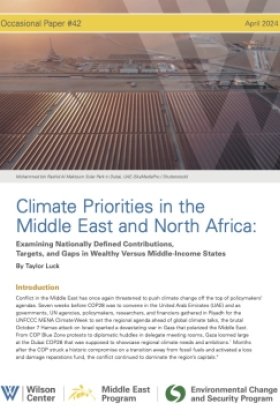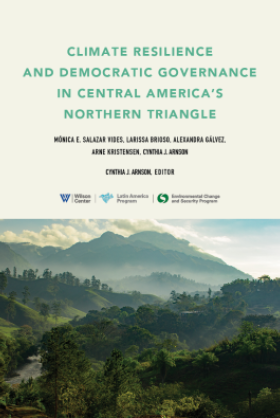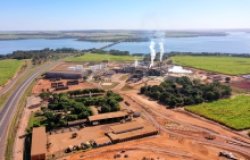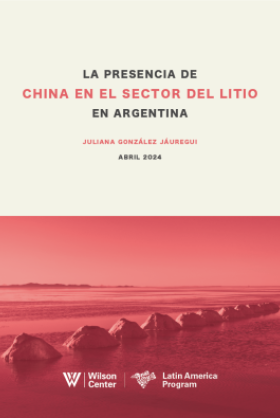The Wellbeing of Nations: Developing Tools for Measuring Sustainable Development
Overview
Featuring Robert Prescott-Allen, PADATA and author of The Wellbeing of Nations;
Thomas E. Lovejoy, Lead Environmental Specialist for Latin America and the Caribbean, The World Bank (introduction);
and Melinda Kimble, Senior Vice-President for Programs, UN Foundation (discussant)
October 11, 2001—While "sustainability" and "sustainable development" are two of the key concepts for 21st century national and global policymaking, the terms often evoke glazed eyes and lip service, according to researcher and consultant Robert Prescott-Allen. To reinvigorate and sharpen these concepts, Prescott-Allen has invented several indices of human and ecosystem well-being that he says are much broader (and more precise) yardsticks of progress and health than such well-known indicators as the Gross Domestic Product or the Human Development Index. Prescott-Allen introduced his findings and his new Island Press book, The Wellbeing of Nations: A Country-by-Country Index of Quality of Life and the Environment, to a Wilson Center audience of population, development aid, and environment experts.
"An Enormous Advance"
In introducing Prescott-Allen, Thomas Lovejoy of the World Bank (and co-chair of the ECSP Advisory Committee) called the theme of The Wellbeing of Nations "a topic thoroughly fundamental to the problems of today and the events of a month ago [the terrorist attacks on the United States of 11 September 2001]." Lovejoy praised Prescott-Allen both for his "scrupulous homework" and his refusal to be content with a simply statistical portrait of his subjects. "He has been to many of the places that his book covers," said Lovejoy. He called The Wellbeing of Nations "an enormous advance in sophistication in grappling with this elusive concept of sustainability."
Two Questions
 Robert Prescott-Allen
Robert Prescott-Allen
Prescott-Allen, who has founded and chaired several influential IUCN-The World Conservation Union projects and has 18 years experience evaluating and advising development strategies on four continents, said that every society should continually ask itself two questions: How sustainable are we? And how well are we? To answer these questions, Prescott-Allen said, we need a formal assessment method to provide clear numeric measurements that can be the basis for policy and can build public consensus for action.
Prescott-Allen defined "sustainability" (which he said is just another way of saying "the good life") as a combination of (a) a high level of human well-being, and (b) the high level of ecosystem well-being that supports it. Much as the white of an egg surrounds and supports its yolk, Prescott-Allen said, an ecosystem surrounds and supports people. Any measure of well-being, therefore, must reflect this interdependence.
The Inadequacy of Present Indices
But why aren't present indices adequate for measuring the state of the world? Prescott-Allen argued that human well-being is both more than the strength of a market economy (which is what GDP measures) or a society's distance from deprivation (as measured by the Human Development Index). Instead, he said, human well-being consists of five dimensions:
* Long lives in good health and a stable population base;
* Wealth to secure basic needs and livelihoods as well as to promote enterprise and prosperity;
* Knowledge to live sustainably and fulfill potential as well as a vibrant culture;
* A community that upholds the freedom of members, has an open and clean government, and which is safe from violence and crime;
* Benefits that are shared equally by males and females and shared equitably among all strata of society.
Similarly, Prescott-Allen said that ecosystem well-being is more than low resource consumption (so it cannot be adequately measured by The Ecological Footprint) as well as more than the sum of a nation's environmental policies and practices (as measured by the Environmental Sustainability Index). Ecosystem well-being, according to Prescott-Allen, also has five dimensions:
* Conserving the diversity and quality of the natural land ecosystem;
* Conserving the diversity and quality of water ecosystems;
* Restoring the chemical balance of global atmosphere and the quality of local air;
* Maintaining all wild species and the genes in domesticated species;
* Keeping resource use within the carrying-capacity of ecosystems.
How To Measure Well-Being
The Wellbeing of Nations contains an exhaustive breakdown of each of these dimensions into the indicators that Prescott-Allen uses to develop his indices. The problem for any such work, Prescott-Allen said, is to convert these "apples and oranges" indicator measurements into common units.
Instead of using the inherently-limited options of physical units or money, Prescott-Allen opted for performance scores, which are the distance between a standard and the actual performance of a country. Using international targets, national standards, and expert opinions to set his myriad performance standards, Prescott-Allen then mapped each country's performances onto a 0-100 scale—making it "readily comprehensible to a wide range of lay people," he said. The numeric scale also allows each score to be summed—for example, water withdrawal, inland water quality, and river conversion can be added to give a cumulative inland waters index for each country. "We can instantly see how any country is performing on any given indicator," said Prescott-Allen.
The Barometer of Sustainability
Prescott-Allen's work has to date yielded four indices: the Human Wellbeing Index (HWI); the Ecosystem Wellbeing Index (EWI); the Wellbeing Index (combining the HWI and the EWI, and thus measuring "sustainability"); and the Wellbeing/Stress Index (a ratio of how much harm a given country's development does to the global ecosystem). The Wellbeing of Nations maps each country's four scores onto a graph that indicates not only how countries are doing in relation to each other, but also how close they come to achieving "sustainability"—defined by Prescott-Allen as a "good" score for both human and ecosystem well-being. "Both must be treated together as equally important," said Prescott-Allen. "There is not a fundamental tradeoff between the two."
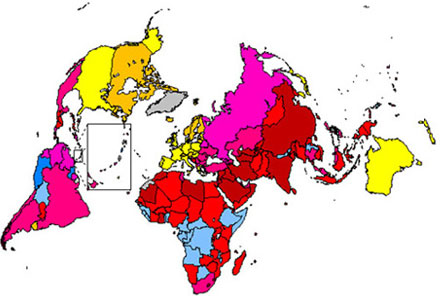
The 180 countries surveyed by The Wellbeing of Nations grouped into ecosystem deficit, human deficit, and double deficit countries.
* Ecosystem deficit (yellow group) = good or fair Human Wellbeing Index (HWI); medium, poor or bad Ecosystem Wellbeing Index (HWI).
* Human deficit (blue group) = fair EWI; medium, poor, or bad HWI
* Double deficit (red group) = both WHI and EWI medium, poor or bad.
* Countries in gray were not surveyed. The map projection is the Dudley equal area projection, chosen because it shows countries' true areas with little distortion of their shapes and makes very efficient use of space.
From Robert Prescott-Allen's The Wellbeing of Nations (Island Press, 2001)
But the picture Prescott-Allen's research produces is of a world with much work to do. Of the 180 countries tracked, only three—Sweden, Finland, and Denmark—achieve "good" HWIs. No country is sustainable or even close (meaning that none scored "good" or "fair" on both the EWI and HWI). "Even though Sweden is at the top of the countries measured," remarked Prescott-Allen, "it is still far from sustainability. This system does not simply compare relative positions from one society to another, but position in relation to something much more important, which is the idea of sustainability and human and ecosystem well-being together."
For individual indices, the news was not much better. The HWI shows two-thirds of the world living in "poor" or "bad" conditions, and only one-sixth of the world living in "fair" or "good" conditions. Most countries do even worse on the EWI: none scored "good", primarily because the index measures not simply the impact of a country on its national environment, but also its impact on the global ecosystem.
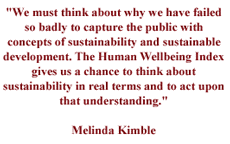 Prescott-Allen labeled 37 countries (including North America and much of Europe) ecosystem-deficit: they have high standards of living but do not have adequate EWIs. Twenty-seven are human-deficit countries: these nations (primarily in Africa) make low demands on the global environment, but are deeply impoverished. And 116 are double-deficit countries—nations with both weak environmental performance and inadequate development. The Wellbeing Index, said Prescott-Allen, can also break down a country's performance into its components, giving a clear picture of its strengths and weaknesses. "For instance, you can see at once that what is pulling the United States away from [sustainability]," said Prescott-Allen, "is air [quality], species and genes [preservation], and equity (the gap between the rich and poor)."
Prescott-Allen labeled 37 countries (including North America and much of Europe) ecosystem-deficit: they have high standards of living but do not have adequate EWIs. Twenty-seven are human-deficit countries: these nations (primarily in Africa) make low demands on the global environment, but are deeply impoverished. And 116 are double-deficit countries—nations with both weak environmental performance and inadequate development. The Wellbeing Index, said Prescott-Allen, can also break down a country's performance into its components, giving a clear picture of its strengths and weaknesses. "For instance, you can see at once that what is pulling the United States away from [sustainability]," said Prescott-Allen, "is air [quality], species and genes [preservation], and equity (the gap between the rich and poor)."
"A Matter of Choice"
"The bleaker image, however," said Prescott-Allen, "is highlighted with some glimpses of hope." For example, the data in The Wellbeing of Nations clearly shows that growth in a country's human welfare (a higher HWI) does not necessarily result in environmental damage (a higher ESI). Prescott-Allen also pointed out that, at any level of development, some countries were clearly achieving the same quality of life for a lower environmental price. Ecuador, for example, has a better ESI than Colombia, even though the two countries have similar HWIs. While environmental conditions play a part in these disparities, Prescott-Allen remarked, there are other factors more readily within the grasp of human beings to change.
"Much of the relation between human well-being and environmental damage is matter of choice," said Prescott-Allen. "The opportunity and capacity to make sound decisions is crucial. A high ratio of human welfare to ecosystem stress is strongly linked to good government, freedom, and good education—all three of which are essential conditions to sound decision-making."
Prescott-Allen urged countries, communities, and corporations to (a) commit to a vision of sustainability based on ecosystem as well as human well-being, and (b) to conduct their own well-being assessments based on their own criteria. "Nobody is going to make up their minds or change their decision-making," said Prescott-Allen, "based on what Robert Prescott-Allen says in a book called The Wellbeing of Nations. They will be able to do it by making their own analyses, using their own data, choosing their own elements and indicators and their own performance criteria." He argued that his method is indeed designed to provide that flexibility and thus uniquely capable to build support for a wide agenda for reaching sustainability. "It is a tool for exposing the things that need greater analysis and action," he concluded.
A Tool For Building Consensus Melinda Kimble called The Wellbeing of Nations a welcome continuation of the work begun by the United Nations Development Programme's Human Development Index. "We must think about why we have failed so badly to capture the public with concepts of sustainability and sustainable development," said Kimble. "The Human Wellbeing Index gives us a chance to think about sustainability in real terms and to act on that understanding."
Melinda Kimble called The Wellbeing of Nations a welcome continuation of the work begun by the United Nations Development Programme's Human Development Index. "We must think about why we have failed so badly to capture the public with concepts of sustainability and sustainable development," said Kimble. "The Human Wellbeing Index gives us a chance to think about sustainability in real terms and to act on that understanding."
Specifically, said Kimble, Prescott-Allen's work is (a) flexible, (b) applicable to developing and developed countries alike, and (c) precise about "where we need to get to work." And while such international policymakers as World Bank President James Wolfensohn has committed to reducing and eventually eliminating global poverty, Kimble said, these policymakers need tools such as the Human Wellbeing Index to make those commitments effective. "We have to think about how [the problem] is more than GDP," she said. "We all know that we need to go farther in our analytic tools so policymakers and analysts can develop a more sophisticated consensus." She also said that The Wellbeing of Nations demonstrates "quite graphically the power of the data in the UN system and how it can be put to work towards the goal of sustainability."
Data and Localities
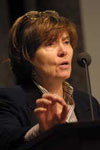 Melinda Kimble
Melinda Kimble
Responding to questions, Prescott-Allen admitted that his indices do not cover fields—such as culture or animal welfare—which have proven difficult to quantify. "I allowed myself the luxury of not spending a lot of time on things for which there is very little data because in fact there are few data available country by country," Prescott-Allen said. "This is not to say that I don't think animal welfare is important—I think it's very important and it should be addressed. There are many indicators, and culture is one of them, that [are] acknowledged in The Wellbeing of Nations as requiring to be covered but [are] not actually covered. I hope that that is something that we can address further down the line." Prescott-Allen also explained that he included gender equality as a factor in calculating HWI and that he is developing a "barometer of equality" to allow these indicators to be mapped on either a gender or general equality basis.
Andrew Deutz, the coordinator of the Temperate and Boreal Forest Programme at IUCN-The World Conservation Union, commented from the floor that Prescott-Allen's methods can also be applied at the local level and in fact are being used as part of a participatory planning process in communities in India, Zimbabwe, and Nicaragua. Deutz said that the system of The Wellbeing of Nations allows direct users to define their own indicators, dimensions, and variables so they can assess their own sustainability and well-being. He added that the indices are also proving fairly effective for (a) evaluating and monitoring sustainable development projects over time, and (b) identifying the key areas for policy and program interventions for development and conservation efforts as well as ensuring a substantial level of local support for such interventions. Deutz also said that IUCN-The World Conservation Union was developing interactive software so that Prescott-Allen's indices could be used by anyone via the Internet.
Current Questions of Policymaking
Prescott-Allen strenuously disputed the common assumption that environmental safeguards come at the expense of economic gain. "There can be ultimately no tradeoff between human well-being and ecosystem well-being," Prescott-Allen said. "The [common] assumption. . .is based on a highly incomplete notion of what the costs might be—they do not look at human well-being in the round, and they tend to be far too facile and simplistic in their cost-evaluation of environmental regulations."
"When you look at things in the round," added Prescott-Allen, "for the United States, even with its current economic problems, wealth is only a small part of U.S. problems—even without discussing the impact of the U.S. economy for world health at large." He added that West Asia, currently the focus of so much attention, has the highest proportion of countries doing badly in human as well as environmental terms. "There is an unfortunate mixture of poverty and environmental degradation in that region," Prescott-Allen said. "The countries score badly on education, peace, and freedom. It's an extraordinarily hard [situation] to turn around."
Glossary
Gross Domestic Product: Gross Domestic Product (GDP) is an economic indicator of national wealth. It measures a country's consumption, government expenditures, investment and net exports.
Human Development Index: The Human Development Index (HDI) was created by the United Nations Development Program to measure a nation's quality of life. It is composed of life expectancy, adult literacy, and per capita Gross National Product.
Ecological Footprint: The Ecological Footprint measures the impact humans have on nature. It is expressed in terms of the amount of productive land and water required to produce the resources consumed and to absorb the waste generated by that population. This measure can be applied to any defined population—including an individual, a city, or a country.
Water Withdrawal: Water withdrawal reduces water flow volumes and, thus, can intensify the effects of river conversion and pollution.
River Conversion: River conservation refers to the building of dams, banks, channels, dikes and embankments. River conversion destroys habitats or degrades them by disrupting water flows.
Documents & Downloads
- The Wellbeing of Nations: Developing Tools for Measuring Sustainable DevelopmentDownload
- The Wellbeing of Nations: Developing Tools for Measuring Sustainable DevelopmentDownload
- The Wellbeing of Nations: Developing Tools for Measuring Sustainable DevelopmentDownload
- The Wellbeing of Nations: Developing Tools for Measuring Sustainable DevelopmentDownload
Hosted By

Environmental Change and Security Program
The Environmental Change and Security Program (ECSP) explores the connections between environmental change, health, and population dynamics and their links to conflict, human insecurity, and foreign policy. Read more
Thank you for your interest in this event. Please send any feedback or questions to our Events staff.
